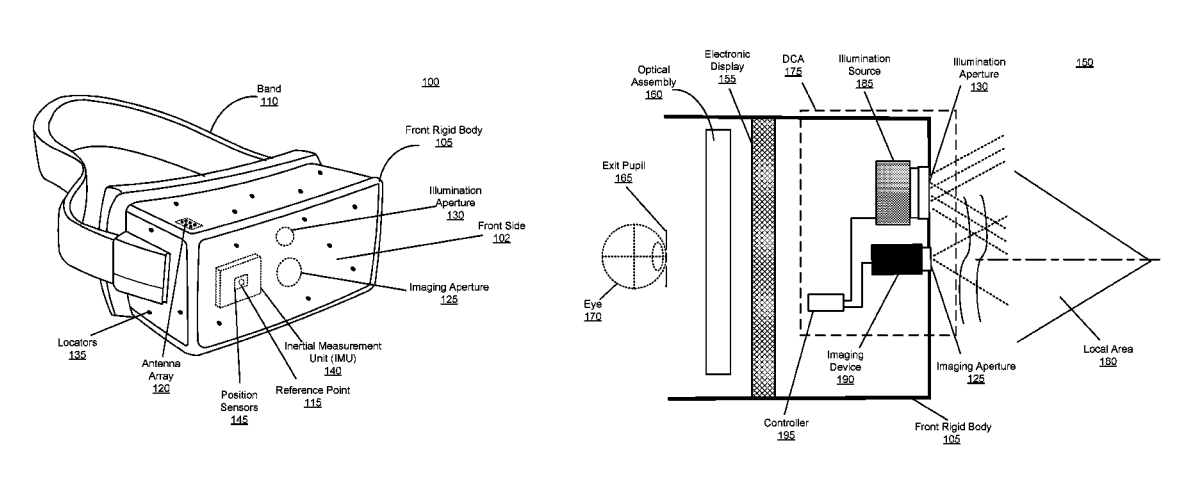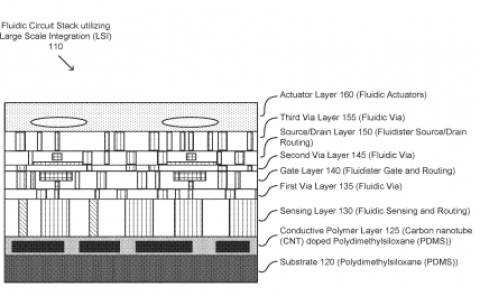Facebook Patent | Positional tracking assisted beam forming in wireless virtual reality systems
Patent: Positional tracking assisted beam forming in wireless virtual reality systems
Publication Number: 10148324
Publication Date: 2018-12-04
Applicants: Facebook Technologies, LLC

Abstract
Embodiments of the present disclosure support a head-mounted display (HMD) wirelessly coupled to a console. The HMD includes a positional tracking system, a beam controller and a transceiver. The positional tracking system tracks position of the HMD and generates positional information describing the tracked position of the HMD. The transceiver communicates with a console via a wireless channel, in accordance with communication instructions, the communication instructions causing the transceiver to communicate over one directional beam of a plurality of directional beams. The beam controller determines a change in the positional information. Based on the change to the positional information, the beam controller determines a directional beam of the plurality of directional beams. The beam controller further generates the communication instructions identifying the determined directional beam, and provides the communication instructions to the transceiver.
BACKGROUND
The present disclosure generally relates to virtual and augmented reality systems, and specifically relates to positional tracking assisted beam forming in wireless virtual reality and augmented reality systems.
It is desirable to establish a reliable and fast wireless communication between a console and a head-mounted display (HMD) in a virtual reality (VR) system, an augmented reality (AR) system, a mixed reality (MR) system, or some combination thereof, to, e.g., "cut the cord" between the console and the HMD. A wireless communication based on extremely high carrier frequencies, such as communication based on 60 GHz carrier frequency in accordance with the IEEE 802.11ad standard or the IEEE 802.11ay standard represents a promising technology for achieving reliable wireless experience in VR, AR and MR systems. A base station (e.g., console) that wirelessly communicates with a client (e.g., HMD) based on 60 GHz carrier frequency employs beam forming to compensate for a path loss and maintain a quality of wireless link above a predetermined threshold value. The base station typically employs the beam forming based on beam training and beam tracking in order to ensure its effectiveness.
In the IEEE 802.11ad standard, the beam training and beam tracking is performed by employing a sector level sweep and a beam refinement protocol. However, the beam training and beam tracking causes a high overhead and large latency. The high overhead of the beam training and beam tracking is due to a feedback communicated between a pair of wireless devices (e.g., the console and the HMD), which consumes an additional communication bandwidth. The large latency of the beam training and beam tracking is due to a latency of the sector level sweep that can be approximately between 2 ms and 100 ms. Thus, the beam forming based on sector level sweep cannot handle typical movements of the HMD as the beam forming based on sector level sweep can support the HMD's movement speeds of only up to a certain speed that is slower than a speed of the typical HMD's movements. A latency of the beam refinement protocol is lower and approximately 200 .mu.s-300 .mu.s per iteration. However, the beam refinement protocol typically needs multiple iterations to determine a preferred directional beam for communication between a pair of wireless devices. If only considering the latency, the beam refinement protocol can support typical movement speeds of the HMD. However, the beam refinement protocol is often subject to many imperfections and may result in data losses. Furthermore, the accuracy of beam training and beam tracking is limited by the digital baseband estimate variation and antenna beam pattern. Because of that, a HMD may not be able to use an optimal beam direction for wireless communication with a console. This may also cause delay between beam switching processes. In addition, the beam training and beam tracking features non-awareness in relation to non-line-of-sight (NLOS) conditions between a pair of wireless devices. In the case NLOS condition is present between the pair of wireless devices, communication based on the beam training and beam tracking cannot provide prompt remedy, which causes loss of data when communicated between the wireless devices.
SUMMARY
Embodiments of the present disclosure support a head-mounted display (HMD) that wirelessly communicates with a console. The HMD and the console may be part of, e.g., a wireless virtual reality (VR) system, a wireless augmented reality (AR) system, a wireless mixed reality (MR) system, or some combination thereof. The HMD includes a positional tracking system, a transceiver, and a beam controller. The positional tracking system is configured to track a position of the HMD and generate positional information describing the tracked position of the HMD. The transceiver is configured to communicate with a console via a wireless channel, in accordance with communication instructions, the communication instructions causing the transceiver to communicate over one directional beam of a plurality of directional beams. In some embodiments, some or all of the directional beams used by the transceiver of the HMD for wireless communication with the console can be directional narrow beams. In alternate embodiments, some or all of the directional beams used by the transceiver of the HMD for wireless communication with the console can be directional wide beams. The beam controller is configured to determine a change in the positional information. Based in part on the change to the positional information, the beam controller determines a directional beam of the plurality of directional beams. The beam controller further generates the communication instructions identifying the determined directional beam, and provides the communication instructions to the transceiver.
The console that wirelessly communicates with the HMD includes a positional tracking system, a beam controller, and a transceiver. The positional tracking system of the console tracks a position of the HMD and generates positional information describing the tracked position of the HMD. The beam controller of the console determines a change in the positional information. Based in part on the change to the positional information, the beam controller determines a directional beam of a plurality of directional beams of the HMD. The beam controller of the console further generates communication instructions identifying the determined directional beam. The transceiver of the console communicates with the HMD via a wireless channel, and transmits the communication instructions to the HMD, the communication instructions causing the HMD to communicate with the apparatus over the determined directional beam.


